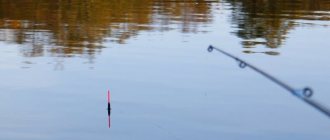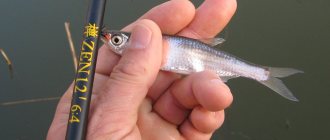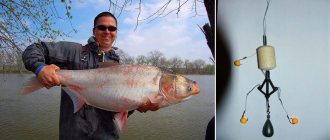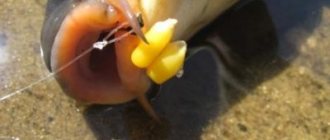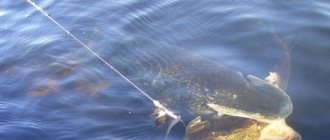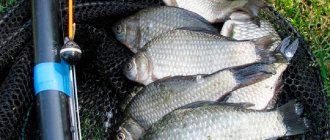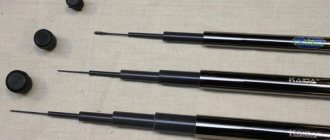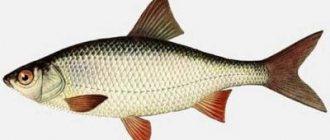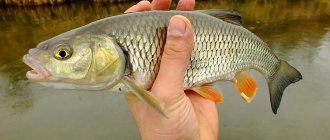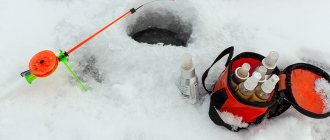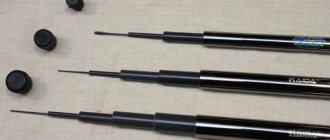Despite the fact that the life cycle of ide is year-round, good bites of this fish cannot be observed in all seasons. The most favorable time for fishing ide is the period after spawning. Catching ide with peas shows excellent results in the warm season. In this article we will talk about how to properly prepare catchable pea bait.
Yaze tackle
Pea bait is most optimally combined with fishing from a boat. Of course, you can fish from the shore, but most fishermen prefer from a boat, since catching ide with peas this way is more interesting and gives you a better chance of returning with a rich catch.
As onboard equipment you will need any classic float rod 1.2 - 1.5 m long with a wire reel and nod, 15 - 20 meters of main line with a diameter of 0.4 mm, 20 - 30 cm of monofilament with a thickness of 0.2 - 0.3 mm for a leash, a sliding sinker and a fixing cambric. Hooks should be thin and light - No. 6-10, with a short shank and a sting curved inward. The peas must be placed on the hook in such a way that they almost completely cover the shank area.
How to prepare gear for catching ide from a boat.
Experienced fishermen recommend using ordinary hog fishing rods 1.2-1.5 meters long, on which a wire reel is installed and a medium-hard nod is required. You should not use longer gear when fishing from a boat, as this may somewhat complicate the processes of casting bait or landing fish if fishing is carried out under trees.
Rods of shorter length are also not a very profitable solution. This is due to the fact that with a fishing rod that is too short, it is not always possible to quickly remove the formed arc of the fishing line (its slack) that appears after casting, and this is an important point, since hooking should be done in a matter of seconds after the fish bites.
Conventional telescopic options with a test load of up to 40 grams are perfect as a fishing rod. When preparing the tackle, special attention must be paid to the quality of the installation of the pussy, which you can make yourself using a spring from a soldier’s cap or purchase a ready-made version at a fishing store.
The nod should be firmly attached to the tip of the rod; its length can be adjusted during the fishing process based on the weight of the equipment used, as well as the activity of the fish. Note that the presence of such a bite alarm guarantees the highest possible sensitivity of the gear, so that even the weakest bite will not go unnoticed.
A fishing line with a cross-section of 0.25 mm (main) is wound on the reel, the leash is made of fishing line, the diameter of which can be in the range of 0.14-0.2 mm (the choice depends on the size of the intended trophy), the length of the leash is 30-50 cm.
The load is installed sliding, you can also use a blind version of the equipment, but in this case it is divided into several parts (3-5) and installed at a distance of 25 cm from the hook and then every 15 cm.
As for hooks, the best options are considered to be options No. 4-5 with a short shank; the tip must necessarily point inward. Note that the hook should be almost completely hidden in the bait used for fishing.

Ide for peas
Recipe for making pea bait
In order for peas to be used as bait, they must be properly cooked. When buying peas, choose wrinkled and unshelled grains rather than smooth ones - they are faster to cook. First you need to fill the pea grains with water and leave for 6-8 hours to swell. You can add a little salt and sugar to the water. After this time, you need to put a container with water and swollen peas on the fire and cook until the grains become soft.
However, be careful not to overcook the peas, as peas that are too soft will have a worse hold on the hook and will clump in strong currents. How the readiness of the bait is checked can be seen in a specially prepared story - “catching ide with peas - video material”:
Drain the remaining water from the container and rinse the grains under cool water. In this way, you will increase the useful life of the prepared bait without allowing it to sour. Place the finished bait in a hard container for transportation so as not to crush the peas along the way.
Pea nozzle
It should be noted that catching ide with peas is quite convenient. After all, properly cooked peas stick well to the hook. Large fish are caught with it, but small fish pass by. Peas can also serve as an excellent option for feeding ide.
It is best to prepare steamed peas for bait. Which, when properly welded, can serve as the key to successful fishing. To be fair, it must be said that ides do not like bread crumbs and various worms, and they only bite on them in rare cases. But you can only catch roaches with such a bait, and even then in the height of summer.
It is best to prepare a pea bait for ide fishing in the following way: take a suitable container into which the peas are poured so as to cover a third of the bowl’s volume. The whole thing is filled with water and left to swell overnight. If the peas have absorbed all the liquid during this time, you can add it.
The swollen peas must be placed on low heat. Directly with water and cook until the peas acquire the required softness. You can check this by crushing a pea with your fingers - if it works, then the bait is ready and you can take it with you fishing. To increase its useful life , peas can be washed with water.
After removing the pan with peas from the heat, it is advisable to sort the peas in advance. Leaving the larger ones for bait. And the smallest and most crushed ones are for bait.
The finished brew can be carried fishing in a glass jar or in a plastic bag. Then the peas will remain flavorful and pliable for a long time. To prevent it from turning sour, it should be protected from sunlight.
If the fishing is planned to be long , and you are going to spend more than a day on the water, then you can also take a can of dry peas with you on the road. Which can be filled with river water and soaked, and cooked over a fire in the evening.
If it was not possible to soak the peas in advance , then you can pour some dry oats into the pan and add dry peas to it. With this mixture, cooking proceeds well and the attachment turns out to be suitable.
This article will reveal all the secrets of catching carp with peas. Here you will be shown how to properly catch crucian carp using the famous spring.
Fishing Features
In summer, ide bites best at a depth of up to 1.5 m. It can be found in bodies of water with a moderate current, near holes or exits, as well as near trees and aquatic vegetation that have fallen into the water. Before starting fishing, you should lightly feed several promising places with the same peas. To provoke an ide to attack, use stepped wiring. This fish likes it when the bait actively plays in the water.
For a more accurate idea of how catching ide with peas occurs, the video will clearly show and tell you about some of the subtleties and features of using this bait:
Catching ide with peas in the fall.
Targeted fishing for ide in early autumn.
Ide is a desired trophy for fishermen. A strong opponent, it is capable of crushing tried and tested gear, and its pinkish meat will delight the discerning gourmet. After spawning, it wanders along the river bed and is caught by chance. 2-3 kilogram specimens are usually considered a highlight of summer fishing. But there is a little-known way of catching ide in the fall. In the middle zone, this time usually begins in the second week of September, when the ide rolls downstream to its winter camp sites. This method of fishing is little covered in literature and on video, and experts in this fishing usually do not give away their secrets. At this time, ide gathers in certain places of the reservoir in significant quantities, driving away any small fish from their feeding area. Of course, there are other fish in the bycatch. But these can be anadromous roach, from 500 grams and above, trophy bream, large subfish. Basically, this is targeted fishing for ide, weighing 0.5 - 2.5 kg, and a dozen beautiful strong fish caught in a short autumn day are a worthy result of fishing.
Special signs of an ulcer site
The ide usually feeds near the shore. Finding the place of its autumn feeding is not difficult, but to do this you will have to walk along the shore, making sure that there are special signs of an ulcer gathering:
- It is necessary to have bushes and snags near the fishing site;
- There should be sharp changes in depth near the shore. The water in such places swirls and rises from the bottom;
- The fast stream slows down near the steep bank;
- The ide often reveals itself by splashing, hunting in such places for bleak in the upper layers of water.
Fishing for ide with peas in the fall is coastal and ideally the angler takes a place upstream from the ide hole in the current so that the stream carries away the sinker and bait
Let's prepare the tackle correctly and stock up on peas for catching ide
For fishing you need a Bolognese fishing rod, the shock-absorbing capabilities of which will determine the success of fishing and the pleasure of the fisherman. The proximity of snags sometimes forces the angler to tighten the clutch of the spinning reel and rely only on the strength of the leash and hook. The thin, sensitive tip will signal the beginning of a bite, so that the angler is not caught off guard by the first furious jerk of the ide. If you hold a flexible rod at a right angle to the fishing line, the ide will get tired in 2-3 minutes. The tackle is extremely simple:
- Main line 0.25-0.22 mm;
- The sliding sinker is an olive, weighing 15-20 grams;
- Leash - 0.18-0.20 mm;
- Pea hook number 10-8 in the Owner classification.
They feed the ide with the same peas, from the hand, periodically throwing several peas downstream, and after catching the ide, sending a whole handful. So a fishing trip takes at least 2 liters of steamed peas. Taking into account these tips, catching ide with peas in the fall will always be effective.
Pea selection
When purchasing peas for fishing, you need to pay attention to their age. It is advisable to take a younger one, since it is much easier to steam and cook. Experienced fishermen recommend using slightly wrinkled peas rather than smooth ones, since after cooking they do not crack and stick well to the hook. If you choose a smooth one, then even during soaking it may burst and will no longer be suitable for the nozzle.
Did you know?!! Peas, like all legumes, are scientifically a fruit, although from a culinary point of view they are classified as vegetables. Indeed, it’s unlikely to make a compote...
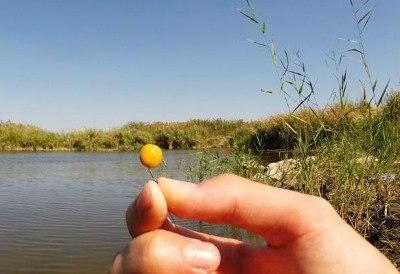
When choosing dry peas for fishing, give preference to the fresh harvest. It must be whole and not half. You can, of course, even use store-bought canned fish; carp also bite on this one. But, as practice shows, canned bait very rarely catches fish over 2 kg. But even a 10 kg trophy carp will not disdain self-steamed peas.
You should also definitely purchase unshelled peas, that is, those with a thin skin that is best visible after cooking. You can most often find such peas only in food markets, where various cereals and animal feed are sold. It is very rare to find unshelled peas in stores.
If you plan to catch carp throughout the year, of course during its warm period, then it is advisable to stock up on a large amount of this bait. After all, it will be useful to us not only for attaching a hook, but also for use as an ingredient in bait, which is an integral part of carp fishing.
Tackle for catching carp with peas
Using peas as bait, carp can be caught using all traditional gear. Some fishermen fish using a float and feeder rod, others use a bottom with a feeder. The gear, especially the reel, must be quite powerful and of high quality.
The main fishing line should have a diameter of 0.3 to 0.35 millimeters; usually, monofilament is used for this. It is better to make leashes from durable braid from 0.12 to 0.18 millimeters. The size of the hooks is from five to eight, the sting should be curved. Such hooks are called carp hooks.
An ancient tackle used in Rus', called a “podstavukha” or “float”, has become widespread. Some fishermen manage to pull out quite large carp using such gear.
The device itself is as follows:
- About fifteen meters of fishing line is wound onto a piece of foam plastic. The color is usually black, the diameter is half a millimeter.
- Next, attach the sliding fork-limiter, attaching it to the float.
- Then comes the fastening of the sliding sinker, which sinks to the bottom when fishing. Its weight is usually from one hundred to one hundred and twenty grams.
- Behind the sinker there is a restrictive ring, then a leash about 50 cm, diameter 0.4 millimeters.
- Sharp carp hooks number eight are used.
The ring on the fore-end of a tied hook is equipped with an additional vinyl chloride nipple. This is done so that the nipple softens the pressure of the fishing line on the hook ring. During the fishing process, large carp twitch very sharply in different directions. The line may break where it cuts into the base of the ring on the hook.
